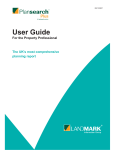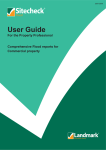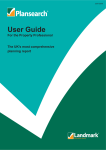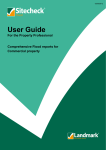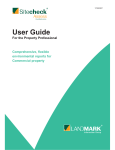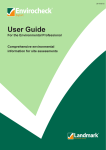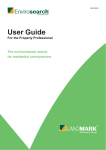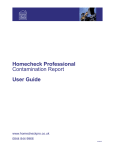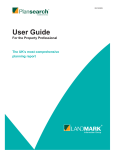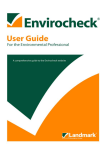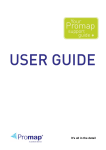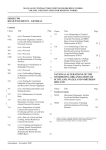Download Sitecheck Planning User Guide
Transcript
11/08/2009 User Guide For the Property Professional Comprehensive, flexible environmental reports for Commercial property Sitecheck Planning User Guide Table of Contents 1.0 Introduction 3 2.0 Ordering a Sitecheck Planning Report 3 3.0 What is Sitecheck Planning? 4 4.0 The Framework and Reporting Style 4 5.0 Summary of Site 4 6.0 Aerial Photo 5 7.0 Location Map 5 8.0 Summary Table 6 9.0 Planning Applications 8 10.0 Development Plans 11 11.0 Local Development Framework 12 12.0 Mobile Phone Masts 13 13.0 Rights of Way 13 14.0 Housing and Neighbourhood 13 15.0 Crime 14 16.0 Education 15 17.0 Amenities 16 18.0 Useful information 18 19.0 Contacts 18 20.0 How do I proceed now 18 Appendix Appendix 1: Scope of the Planning Applications 19 Appendix 2: Location Accuracy used in Sitecheck Planning 20 Appendix 3: Data sets used in Sitecheck Planning 21 Appendix 4: Ordnance Survey Legend 24 Appendix 5: The National Grid 27 2 Sitecheck Planning User Guide 1.0 Introduction 1.1 Landmark Information Group is the leading supplier of environmental, land-use and mapping information in Great Britain. Formed in April 1995 we have developed a reputation for quality combined with value for money, providing the best available information in a user-friendly, timely and relevant manner. 1.2 We aim to deliver excellent Customer Service. Whether you need help locating a site, assistance in determining the right report for you, require additional information, have a question for our helpdesk or a general query we have an experienced team ready to talk to you. In addition, clients have access to their own Account Manager. 1.3 Copies of this User Guide can be downloaded free of charge from the Sitecheck website at www.sitecheck.co.uk or obtained from our Helpdesk team by calling 0844 844 9966. 2.0 Ordering a Sitecheck Planning Report 2.1 The quickest and perhaps most efficient way to order your Sitecheck Planning report is via our web site – www.sitecheck.co.uk. Register on line or call our Helpdesk team on 0844 844 9966 to set up your individual user name and password. 2.2 To order a report using one of our order forms please contact: Landmark Information Group Limited Legal & Financial The Smith Centre Fairmile Henley-on-Thames RG9 6AB Telephone: Fax: DX: E-mail: Internet: 0844 844 9966 0844 844 9980 154400 Henley-on-Thames 2 [email protected] www.sitecheck.co.uk 2.3 It is important that each order form is accompanied by a location plan, clearly showing the site boundary in relation to established features. If the site is a new development the developer’s plan and Land Registry plan should be submitted to aid us in site identification. If in doubt please call for clarification, as orders submitted without a location plan may be delayed. 2.4 Order forms and plans may be sent by post, fax, or by DX using the address details above. 2.5 You may request to receive reports in PDF format by e-mail or in printed form. Extra printed copies are available on request. 2.6 Sitecheck Planning is available in PDF format within 24 hours, or within 2 working days if a paper report is required. 3 Sitecheck Planning User Guide 3.0 What is Sitecheck Planning? 3.1 Sitecheck Planning is a cost-effective screening report, which is designed for individual sites or portfolios. The report contains essential information about proposed developments and land use designations near a property, ensuring property professionals and their clients have key information allowing the client to make an informed decision when moving to new commercial premises. For the legal practitioner it forms part of the means to fulfil best practice in commercial conveyancing matters. 3.2 Each Sitecheck Planning report contains information on planning applications identified on the actual site and up to 1000 metres from the site boundary. It also contains information on land use extracted from Local Development Plans and Local Development Framework documents up to 500 metres from the site boundary. 3.3 As well as the details of planning applications and land use designations, Sitecheck Planning contains further useful neighbourhood information including data on schools, crime rates, insurance claims and population demographics. 4.0 The Framework and Reporting Style 4.1 The Sitecheck Planning report comprises fifteen sections: Summary of Site Aerial Photo Location Map Summary Table Planning Applications Development Plans Mobile Phone Masts Rights of Way Housing and Neighbourhood Crime Education Amenities Useful Information Useful Contacts Terms and Conditions 4.2 The sections of the Sitecheck Planning report are explored in detail in the following paragraphs. The report reveals results in the order found in the Summary table. 5.0 Summary of Site 5.1 Each section provides details under each heading of any features that have been identified onsite, these will include Planning Applications, Development Plans, Mobile Phone Masts and Amenities. If no features are identified in a particular section that part of the table is not produced. The information is derived from the data sets shown in Appendix 3. 4 Sitecheck Planning User Guide 5.2 A page number is given to aid location of the record in the body of the report. In electronic versions of the report this number is a hyperlink which will take you directly to that page when clicked. 5.3 Where applicable a Reference Number (Map ID) is listed in the table which appears on the relevant maps next to the relevant symbol. Each Reference Number relates specifically to the feature on the map. 6.0 Aerial Photo 6.1 The Aerial Photo gives an overall view of the area centred on the bearing reference point of the site. The area shown is a 270 metre square on the ground, which does not expand for larger site areas. 6.2 To the bottom right of the photo there is an Ordnance Survey map showing the site and 250m search buffer. 6.3 Adjacent to the map you will find the site location description and a six figure National Grid Reference, relating to the bearing reference point for the site, rounded to the nearest 10 metres. This is indicated on the information maps by a pink site boundary. To convert this National Grid Reference to an alphanumeric string, please refer to Appendix 5. The Report Reference, Customer Reference and Size of Site are also included. 7.0 Location Map 7.1 The map confirms the boundary of the subject site used to drive the report. The site boundary is marked in pink and displayed against Mastermap®, the most detailed Ordnance Survey mapping. Since all sites differ in shape and area this map is not reproduced at a set scale. The minimum distance from the site boundary to the map frame boundary is 50 metres. 7.2 Users should check the boundary is correct on receipt of their Sitecheck Planning report. Please call our Helpdesk team on 0844 844 9966 if you have an issue with the boundary. 7.3 The background map contains both features and descriptive text, which may contain information not reported in the body of the report but relevant to the reader. Examples are water features (marked in blue on the map), text for tanks, electricity sub stations, factories, works and schools, shapes indicating tanks, benchmarks and spot heights. 7.4 To the bottom right of the main map there is a further small aerial photograph. 7.5 Adjacent to the small aerial photograph you will find the site location description and a six figure National Grid Reference, relating to the bearing reference point for the site. Rounded to the nearest 10 metres. This is indicated on the information maps by an “X”. To convert this National Grid Reference to an alphanumeric string, please refer to Appendix 5. The Report Reference, Customer Reference and Size of Site are also included. 5 Sitecheck Planning User Guide 8.0 Summary Table 8.1 The Summary Table comprises a set of four tables that list the information found for the site and the vicinity, derived from the data sets shown in Appendix 2 as per the following examples: Example of the Planning Application section Example of the Development Plans section Example of the Mobile Phone Masts section 6 Sitecheck Planning User Guide 8.2 The summary tables give the data set name and the total number of records identified for each buffer. The table replicates the order of the detailed records within the body of the report. 8.3 Users should note that some features are not mapped. 7 Sitecheck Planning User Guide 9.0 Planning Applications 9.1 This section comprises a map, showing application locations, and tables showing the application details (see Appendix 1 Scope of Planning Applications). The map extends to 300 metres from the search centre for reports in an urban area and 500 metres from the search centre for reports in a rural area. It should be noted that, because of the size of map symbols it is sometimes necessary to group applications within 50 metres together under one symbol. Minor applications and applications with low location accuracy are not mapped. 9.2 A summary is included at the start of the section. Any large, small and minor applications identified on site are listed. This is followed by a table which gives a count of the number of applications identified in each classification for each search buffer. 9.3 Records are split into large, small and minor applications. Large applications are those which have an estimated value above £100,000. Minor applications cover things such as single storey extensions, conservatories, porches, signs and car ports. Large applications date from 1997, small applications from 1998 and minor applications from 2006. 9.4 Large and small applications are divided into 9 classifications as follows: • • • • • • • • • Agricultural. Catering. Civil Engineering, including demolitions. Commercial (Industrial, Office, Retail). Education, Health, Military, Municipal. Power, Water, Telecoms, Waste. Residential. Sport, Leisure, Entertainment. Transport. Minor applications are not classified but will appear in the summary table under the heading of "Minor Development". 8 Sitecheck Planning User Guide 9.5 The reporting search buffers vary depending on whether the report is on a property in an urban or rural location as per the table below. Application type 9.6 Search Buffer Urban Rural Minor 100 metres 300 metres Small 250 metres 400 metres Large 300 metres 500 metres Low Location Accuracy 800 metres 1000 metres Following the summary section, the details of all the applications identified are listed in tables, split by application type and classification. The details revealed are: • Address The address collected for the application. • Distance The distance from the site boundary. This column will not be included in the table of applications with low location accuracy as their location is uncertain. • Reference The application reference number. • Date The application date as listed by the local authority. • Type The development type. Categories are: new build, refurbishment or repair, alteration or conversion, demolition, extension, fit out, works, listed building consent and power supply lines. Where no category has been provided this is noted as "not supplied". • Location Accuracy The accuracy with which the application is located (See Appendix 2). • Decision The application decision. Reported decisions are; detailed planning granted, outline planning granted, detailed planning refused, outline planning refused, application withdrawn and not applicable. Not applicable is used when the application is first provided and no decision has been made. Please note: Where an application is refused it is possible that it may later be granted on appeal. Landmark's data provider will continue to monitor refused applications only if it appears likely at the time of the original refusal that an appeal will be lodged. If there is a delay between the refusal and an appeal it is unlikely that any appeal result will be reflected. 9 Sitecheck Planning User Guide 9.7 The table also includes columns indicating: • Ref. No. The Ref. No. on the map showing the location of the record. This will be blank if the application falls outside of the map area. This column will not be included in the tables for minor applications and those with low location accuracy, as these records are not mapped. • Search Buffer This indicates the search buffer in which the record is located. • Direction This gives the direction of the record position from the site bearing reference point. 9.8 Where no application reference or application date is shown the record is likely to be information gathered from the trade press or tender requests. In most cases these projects will be in the very early pre-planning stage or that the proposed works do not require planning permission. 9.9 Road, rail, utility and large development applications often do not have definite addresses but are identified with general descriptions. As a result, this report may show such applications by reference to a single point rather than the whole length/area of the project. In many cases the projects will be about changes to existing infrastructure (e.g. road resurfacing and existing buildings), and therefore may be identified by using the map. However, in cases of ‘new build’, identifying the length/area of the project is more difficult. 9.10 Because of the way that large development sites are recorded with a single point reference, in some circumstances, applications for development will not be recorded in the Sitecheck Planning report, even though the application site lies substantially within the search area. For this reason, for road, rail utility and large development applications, the Land Use Designations sections of the report should also be referred to, as this will give further clues as to the location of new development. We suggest that you then contact the relevant local planning authority for further information. 9.11 Some developments do not require an express grant of planning permission, perhaps because its impact on an area would be small, or because it would involve a land use which is very similar to an existing use. This sort of development often takes place under what are known as ‘permitted development rights’, and it is therefore often referred to as ‘Permitted Development’. Examples of permitted development rights include, changes to the inside of buildings, or small exterior alterations that do not significantly alter the volume or area of a building. 9.12 In some areas of the country permitted development rights are more restricted. This may be because land is within an area designated as a National Park, Area of Outstanding Natural Beauty or Conservation Area, or it may be because a local authority has formally decided to revoke or modify permitted development rights under what is described as ‘article 4 direction’. Development rights are also restricted where a listed building is involved. 10 Sitecheck Planning User Guide 10.0 Development Plans 10.1 The information in this section is derived from development plans and documents obtained from the local planning authorities. The section is split into several sub sections depending on what planning policy documents are available for the area of the search. 10.2 The Approved / Adopted & In Progress tables list Planning policy documents which have been, or are in the process of being, published by authorities relevant to the search area. The first table highlights policies & plans approved by the LA. The second table identifies LDF policies currently in progress and which are yet to be finalised. Information from these documents will not be included in Landmark’s data and therefore you may wish to research these documents independently. This list of development plans is based on boundary information available to Landmark at this time. As a result of boundary changes some plans relating to neighbouring authorities may therefore be shown. 10.3 Policies, Proposals and Land Use Designations This sub-section starts with a summary table listing policies identified on site and within 500 metres of the site boundary. For ease of use, policies have been standardised into 10 categories outlined in section 10.4 below. T he summary shows a count of all the mapped policies of the latest adopted local plan and any subsequent deposit draft. 10.4 Land use policy classifications differ between local planning authorities and there are also significant differences in the way policies are expressed. For the purposes of the report, a standardisation process has been undertaken in order to produce a nation-wide classification system which has 10 categories in total. Each category will have associated policies, which determine the circumstances in which development may be permitted. Information about these can be obtained from the relevant planning authority. The following is an overview of the classifications used in the report. The 10 Categories are: • Housing Residential and other housing developments, including re-development and conversion. • Transport Transportation including planned corridors for new roads, minor and major road and rail alterations and a diverse range of cycle, pedestrian and parking policies. • Open Land Includes green belts, nature conservation areas, Sites of Special Scientific Interest (SSSI), etc. Policies normally relate to the preservation of such areas and restrictions on residential or any other development. • Heritage Environment Areas of many towns are designated as conservation areas under statutory powers. Additional statutory hurdles will be in place, and policy constraints are also often imposed concerning the types of construction that will be allowed. 11 Sitecheck Planning User Guide • Town Centre and Retailing Includes retailing areas, town centres and retail servicing areas. • Industrial and Commercial Includes commercial development sites, offices, warehousing, hotels and business and industrial use in general. • Community and Social facility Includes health, education, sport, leisure and social areas and allotments. • Waste, Pollution, Includes waste processing and disposal sites, land use for Minerals, Water and utility purposes (such as sewerage) and potential development Energy hazard areas. • Settlement Limit Limit of urban and village areas (ie the boundary with “rural” areas). • Other (Including mixed use) Areas and sites not covered by the previous classifications. It should be noted that these classifications may change over time. 11.0 Local Development Framework This sub-section gives information on relevant documents from the Local Development Framework. It starts with a summary table listing policies identified within 500 metres of the search centre. A list of Development Plan Documents included in the section is also included. For ease of use, policies have been standardised into 11 categories. The summary shows a count of all the mapped policies of the latest adopted plan and any subsequent deposit draft. 11.1 As with Local Plans, land use classifi cations used in Development Plan Documents differ between local planning authorities and there are also signifi cant differences in the way policies are expressed. For the purposes of the report, a standardisation process has been undertaken in order to produce a nation-wide classifi cation system of 11 categories in total. Each category will have associated policies, which determine the circumstances in which development may be permitted. Information about these can be obtained from the relevant planning authority. The 11 categories are: • Housing • Transport infrastructure • Open Environment • Heritage Environment • Retail and Town Centres • Economy • Community and Social Facilities • Resources and Waste • Boundaries • Rural Settlement • Other Area/Sites 12 Sitecheck Planning User Guide 11.2 Maps showing extracts from the adopted and deposit plans appropriate for the search area follow the summary with any land use policies highlighted. 11.3 Base mapping of an appropriate scale to suit the original document will be used. Although designations will be shown to the edge of the map window only those within the 500 metres buffer will be reported. 11.4 A brief description of the policies and land use designations identified are shown in a table. The direction and distance, classification, list of the policies and the description of the document in which they are found is included. If further information on specific policies is required you should contact the relevant local authority. Details may also be available from the local authority website. 11.5 For a comprehensive understanding of the policies and proposals affecting your area it is wise to contact the local planning authority or refer to the entire Development Plan Document. 12.0 Mobile Phone Masts This section comprises of an Ordnance Survey map and a table containing details of any records revealed. 12.1 The map shows locations of any mobile phone base stations and masts identified within 500 metres of the search centre. 12.2 The table gives a site reference, the operator name and station type. Further details on mast height, frequency range, transmitter power, maximum power and transmission type are also included. 12.3 If no mobile phone base stations or masts are identified within 500 metres of the search centre the table is replaced by text stating “No mobile phone masts have been identified within 500 metres of the search location”. 13.0 Rights of Way This section comprises of an Ordnance Survey map with footpaths, bridleways and other rights of way indicated. The map and data for this section is derived from Ordnance Survey Explorer maps. As well as indicating the public rights of way and footpaths, the map shows a range of other features. The full Ordnance Survey legend for these features is included at Appendix 4. 14.0 Housing and Neighbourhood This section comprises of housing and neighbourhood information as follows. 13 Sitecheck Planning User Guide 14.1 Housing Market Includes postcode sector based information on home ownership and housing type, and postcode based information on average property prices. Where there are less than 16 addresses in the postcode the property price information is derived from the wider postcode sector. The average price bands are calculated by Landmark’s data supplier EuroDirect, using the latest available data from Her Majesty’s Land Registry. They represent a snapshot in time as at the most recent date. 14.2 Council Tax Information Includes details of the local authority for the search centre and local council tax bands. Local tax costs are compared to the national average. 15.0 Crime This section comprises of crime information and gives details of the crime reporting area and the number of households, population and the police force for that area. The tabular information gives local totals under 6 categories of offence and relates these to national figures per thousand of population or, in the case of burglaries, per thousand households. 15.1 Theft Insurance Claim Rating This section indicates the risk of a claim being made for theft within the postcode sector. The risk is determined by comparing the number of theft insurance claims per 1000 properties. • “High Risk” is a sector with more than 4 claims per 1000 households • “Medium Risk” is a sector with between 2 and 4 claims per 1000 households • “Low Risk” refl ects few claims, with less than 2 claims per 1000 households • “Very Low Risk” indicates no claims records. The figures may be the result of one event or cumulatively over time and are indicative only. A sector may appear to have a higher risk due to repeated claims on a single property or group of properties. 14 Sitecheck Planning User Guide 16.0 Education This section gives information on state primary schools and state and independent secondary schools, further and higher education establishments. It comprises of an Ordnance Survey map, indicating the locations of any schools identified, and academic results tables containing details of each school revealed. Searches in Scotland and Wales use different data than searches in England and will contain a different table as described below. The search extends to 2 kilometres radius for searches in urban areas and 5 kilometres radius for searches in rural areas. 16.1 Primary Education Table (England) This table gives a map ID, School Name, School type, Age Range, Number of Pupils and Academic results in Maths, English and Science. Academic Results show the percentage of eligible pupils who achieved Level 4 or above in English, Maths and Science tests. (Level 4 is the standard expected of most 11 year olds). “-” may appear in the results section because: • There were 10 or fewer eligible pupils on the school roll. • The school has 10 or fewer day pupils of compulsory school age enrolled. • There are no results for reasons beyond the school’s control. 16.2 Secondary Education Table (England) This table gives a map ID, School Name, School type, Age Range, Number of Pupils. Academic results give percentages of 5+ grade A* - C GCSE’s, 5+ grade A* - G GCSE’s and average GCSE/GNVQ points per pupil. Each student’s best eight GCSE/GNVQ results are used to give their GCSE/GNVQ point score. From these figures the average score for all eligible students is given. “-” may appear in the results section because: • Schools (except special schools) with at least one 15 year old pupil but no GCSE/ GNVQ entries for these. • Special schools with at least one 15 year old pupil but no GCSE/GNVQ entries for these. • No information available. 16.3 Sixth Form Education Table (England) This table gives a map ID, School Name, School type. Academic results give Number of entries, AGNVQ average points per student and AGNVQ average points per exam entry. The following link should be used for to obtain details of sixth form performance tables from the Department of Education and Skills website. http://www.dfes.gov.uk/performancetables/16to18_06/d3.shtml 15 Sitecheck Planning User Guide 17.0 Amenities This section comprises a map, showing amenity locations, and tables showing amenity details. The map extends to 1 kilometres from the search centre for reports in an urban area and 2 kilometres from the search centre for reports in a rural area. Only the nearest location in each amenity category is shown on the map. 17.1 Following the map the details of all the amenities identified are listed in a tabular form, split classification. The details revealed are: • Amenity • Name • Address • Reference No. The type of amenity. The name of the amenity. The address of the amenity. The Ref No. on the map showing the location of the record. This will be blank if the amenity listed is not mapped. • Distance/Direction The distance and direction from the search centre. 17.2 A complete list of all the amenity categories reported together with the maximum number of entries returned and the search radius for urban and rural reports is detailed in the following tables: Amenities table Amenity Max. No. Reported Search Radius Urban Rural 5 500m* 1km* 5 500m* 1km* 5 500m 1km 5 500m 1km 5 1km 2km Botanical and Zoological 5 1km 2km Historical and Cultural 5 1km 2km Recreational 5 1km 2km Tourism 5 1km 2km Retail and Eating Out Retail Food, Drink and Multi-item Retail *Except ‘Supermarkets’ which are 1km Urban/2km Rural Household, Office, Leisure and Garden *Except ‘Shopping Centres and Retail Parks’ which are 1km Urban/2km Rural Motoring Eating and Drinking Eating and Drinking Recreational and Environmental Accommodation Accommodation Attractions 16 Sitecheck Planning User Guide Amenities table continued: Amenity Max. No. Reported Search Radius Urban Rural 2km Sport and Entertainment Entertainment Support Services 5 1km Gambling 5 1km 2km Outdoor Pursuits 5 1km 2km Sports Complex 5 1km 2km Venues, Stage and Screen 5 1km 2km Commercial Services Commercial Services Hiring and Contract Services 5 1km 2km Legal and Financial 5 1km 2km Personal, Consumer and Other Services 5 1km 2km Property and Development Services 5 1km 2km Recycling Services 5 1km 2km Transport, Storage and Delivery 5 1km 2km Education and Health Education and Health Animal Welfare 5 1km 2km Education Support Services 5 1km 2km Health Practitioners and Establishments 5 500m* 1km* *Except ‘Hospitals’ and ‘Accident and Emergency Departments’ which are 1km Urban/2km Rural Health Support Services 5 500m 1km Primary, Secondary and Tertiary Education 5 1km 2km Recreational and Vocational Education 5 1km 2km Extractive Industries 5 1km 2km Farming 5 1km 2km Foodstuffs 5 1km 2km Industrial Features 5 1km 2km Industrial Products 5 1km 2km Central and Local Government 5 1km 2km Infrastructure and Facilities 5 500m* 1km* 5 500m 1km Air 5 1km 2km Road and Rail 5 1km 2km Transport Access Points 5 1km 2km Walking, Riding and Cycling 5 1km 2km Water 5 1km 2km Manufacturing and Production Manufacturing and Production Public Infrastructure Public Infrastructure *Except ‘Recycling Centres’ and ‘Refuse Disposal Facilities’ which are 1km Urban/2km Rural Infrastructure and Facilities Transport 17 Sitecheck Planning User Guide 18.0 Useful Information The Useful Information is a summary of the main points contained in this User Guide and is intended to help those analysing the report to understand its contents. 19.0 Contacts The contacts section gives details of contacts where more information can be obtained. 20.0 How do I proceed now? Sitecheck Planning constitutes what is known as a ‘desk study’, which is an information-gathering exercise. The practitioner should now discuss the implications of the information with their client. 20.1 Clear search or no perceived problems The search may reveal no entries of any concern whatsoever, and the practitioner may advise the client to proceed, safe in the knowledge that quality information has been obtained. Keeping the search with the file or deeds will assist if future reference needs to be made to the information disclosed at the time of the report. 20.2 Searches showing planning information of concern In some cases the search will reveal entries that may be of some concern to the purchaser or homeowner. We try to highlight significant entries in the summary page, but the report should be read fully to determine exactly what may be of concern to the buyer. The practitioner should discuss these issues with the client to decide whether further investigation or enquiry is required or desirable. 20.3 If further information is to be sought the practitioner should use the Contacts section to determine who the contact is, and contact the relevant organisation quoting the planning application reference or plan name, policy and chapter. 20.4 The decision to proceed, to undertake further investigations or to withdraw must be the client's, informed by the practitioner’s advice. This will frequently depend on factors unrelated to the planning information revealed by the Sitecheck Planning report. Factors such as the cost of further investigations, the difficulty and delay involved in undertaking them, the accuracy and helpfulness of the further information revealed, the general timescale of the transaction and the client’s attitude to risk will all influence the decision. 18 Sitecheck Planning User Guide Appendix 1 : Scope of Planning Applications The data suppliers have indicated that the following categories of application may be excluded from their data and consequently may not be included in Sitecheck Planning. Please also note that the list provided may not be exhaustive. Application Type Remarks Boreholes Exploratory Circular 18/84 Development by the Crown, a government department or the Duchy of Cornwall. County Matters In those areas where there are two tiers of local authorities, most planning applications are dealt with by the district authority but some are considered and decided at county level. Listed Building (if full planning on list) A planning application and application of listed building consent should be lodged together, if needed. The report will just cover the planning application in this case. Some works (eg internal alterations) will only require listed building consent. Overhead Lines 19 Sitecheck Planning User Guide Appendix 2 :Location Accuracy Used in Sitecheck Planning Plansearch Plus Description Explanation GOOD These planning applications have been supplied with sufficient address detail to locate them to the actual site. It should be noted however that where the address relates to a larger site, the application can only be located to a single point within the site. For example, a school may cover a relatively large area with a number of buildings. In this case it is represented as a single point within the boundary of the school. In certain instances, direct verification from the relevant local authority is sought as to the correct location, and these applications are also classed under this description. FAIR Applications often relate to new sites which have not been given a postal address by the Royal Mail. Consequently, the local planning authority or applicant relates the site to an adjacent address. For example, “Land adjacent to No.2 High Street, Townsville”. In these instances, the application has been located to this adjacent address. APPROX In a small number of cases the address supplied with the application is insufficient to locate it accurately. Where the location of the road referenced within the application can be identified and it is less then 300 metres in length, the application is located to this road. WIDER AREA Occasionally the address supplied with the application is insufficient to locate it with any accuracy at all. However it is usually possible to identify the general vicinity of the site usually within a distance of 1000 metres. MULTIPLE SITES Located at one of the multiple sites supplied. In certain instances, an application is supplied with more than one address. In these instances, the application can only be located to one of the addresses supplied. Generally, such records may not involve an actual planning application. 20 Sitecheck Planning User Guide Appendix 3 : Data Sets Used in Sitecheck Planning Title Crime Development Plans Education Establishments Remarks This data set details the recorded totals for 6 key offences: Violence against the person; Sexual offences; Robbery; Burglary of a dwelling; Theft of a motor vehicle; Theft from a vehicle, as defined by Crime and Disorder Reduction Partnerships. This data set is a listing of all the development plans published by Local Authorities and County Councils in England, Scotland and Wales. It includes not just Local Plans, Unitary Plans and National Park Plans, but also details of Structure Plans, Mineral Plans, Waste Plans, Mineral & Waste Plans and Regional Park Plans. Source Data Type Data Range Update Cycle Section Home Office Text Previous Financial Year Annually Crime Devplan Text Various Monthly This data set contains information on DfES (Edubase) addresses and types of educational establishments. This data set is geocoded Welsh Assembly by Landmark. Scottish Text Land Use Policies are collected from Local Authorities throughout Great Britain. Local planning authorities are required to prepare planning strategies for their area in accordance with Sections 36 and 54 of the Town and Country Last Academic Annually Education Annually Education Annually Education Year Text Last Academic Text Last Academic Year Executive Local Plan Features Land Use Designations Year Local Authorities Point, line, area & text Variable Variable Land Use Designations Local Authorities Point, line, area & text Variable Variable Land Use Designations Planning Act 1990 (as amended) in England and Wales, and Section 2 of the Town and Country Planning (Scotland) Act 1997. Plans are produced by district councils, unitary councils and National Park authorities in which detailed policies are set out to guide development in the Local Authority area. The plans may include detailed proposals for individual sites as well as identifying areas suitable for housing, industry, retail, conservation or other land uses. The plan forms the statutory basis for planning decisions and provides a means of public consultation and control over development. Depending upon the stage of consultation with the public, Plans are unadopted (eg, ‘deposit’ plans) or adopted. Local Development Plans Land Use Policies are collected from Local Authorities throughout Great Britain. Local planning authorities are required to prepare planning strategies for their area in accordance with Sections 36 and 54 of the Town and Country Planning Act 1990 (as amended) in England and Wales and The Planning and Compulsory Purchase Act 2004. The Local Development Framework (LDF) is a non-statutory term used to describe a folder of documents, which includes all the local planning authority’s local development documents. An LDF is comprised of Development Plan Documents (which form part of the statutory development plan) and Supplementary Planning Documents Plans are produced by district councils, unitary councils and National Park authorities in which detailed policies are set out to guide development in the Local Authority area. The plans may include detailed proposals for individual sites as well as identifying areas suitable for housing, industry, retail, conservation or other land uses. 21 Sitecheck Planning User Guide Appendix 3 : Data Sets Used in Sitecheck Planning Title Remarks Source Data Type Data Range Update Cycle Section Mobile Phone Masts This data set provides a listing of mobile phone base stations and masts within the UK (excluding Isle of Man). The information provided includes location and operator name, and further details on mast height, frequency range and power. OFCOM Point & Text 2006 As Notified Mobile Phone Masts Performance Tables (Primary Schools) The primary school performance tables have been published by individual local education authorities (LEAs) in respect of state schools in their area. All LEAs are required to publish the Key Stage 2 National Curriculum test results of 11 year old pupils in state school in England, together with certain background details DfES Text Last Academic Annually Education Annually Education Annually Education Year for each school. This data has been geocoded by Landmark. Performance Tables (Secondary Schools) This data provides information on the achievements of students in state and independent secondary schools. They include GCSE and GNVQ results for 15 year olds (students in their final year of compulsory schooling) and come from the awarding bodies concerned. The information contained in this dataset provides only part of the picture of each DfES Text Last Academic Year school’s overall achievements. The tables should therefore be considered alongside other important sources of information such as Ofsted reports, school prospectuses and Governors’ Annual Reports. This data has been geocoded by Landmark. Performance Tables (Sixth Form) This data set includes all state and independent schools with sixth forms and Further Education sector colleges with results in England. Each entry provides information about the achievements of students over the current academic year in General and Vocational A and AS level examinations, key skills at Level 3 and in a number of other advanced and intermediate qualifications. This data has been geo-coded by Landmark. Planning Applications Applications for planning permission submitted to local authorities. Developments not requiring planning permission are excluded. This data is collated, classified and geo-coded by Landmark. Points of Interest This data set contains PointX locations for points of interest and contains records from various provenance. PointX data as a whole has a coverage of Great Britain (excluding the Isle of Man). The data has been geocoded by Landmark. DfES Text Last Academic Year Barbour ABI Point & Text Since 1997 (large),1998 (small) and 2006 (minor) Weekly Planning Applications Point X Point & Text N/A Quarterly Amenities 22 Sitecheck Planning User Guide Appendix 3 : Data Sets Used in Sitecheck Planning Title Remarks Source Data Type Data Range Update Cycle Section Postcode Sector Insurance Claim Ratings - Theft This data set is supplied by Crawford and Company and contains postcode sector based theft insurance claim ratings. Postcode sectors are supplied as digital polygons, to which insurance claim ratings are applied. The rating system has five levels, and is determined by the number of theft insurance claims made within the postcode sector. Four levels range from ‘Very Low’ to ‘High’, whilst the fifth category represents postcode sectors that have too few properties contained within them to make an assessment. Crawford & Co Polygon & Text From 2000 Quarterly Crime Ordnance Survey Point,line & Text From 2001 Bi-annually Rights of Way Rights of Way Derived from Ordnance Survey 1:25,000 Explorer maps. 23 Sitecheck Planning User Guide Appendix 4 : Ordnance Survey Legend 24 Sitecheck Planning User Guide Appendix 4 : Ordnance Survey Legend 25 Sitecheck Planning User Guide Appendix 4 : Ordnance Survey Legend TOURIST INFORMATION 26 Sitecheck Planning User Guide Appendix 5 : The National Grid The National Grid provides a unique reference system to locate any point in Great Britain. Landmark, in all its reports, gives this grid reference (NGR) as a six figure numeric reference e.g. 393200,224400. However, many people feel more comfortable with an alphanumeric grid reference, in which each NGR has a two-letter prefix locating it within one of the 100 kilometre squares shown in the diagram opposite. This alphanumeric form is interchangeable with the purely numeric reference used by Landmark. In order to convert the purely numeric grid references to an alphanumeric reference the following procedure should be used: in general, the last 3 figures of the 6-figure grid reference should be removed (in the case of The North of Scotland 7-figure Northings may occur). The resulting grid reference represents a 100-kilometre reference and thus can be plotted against the adjacent map to provide the correct letter code. This letter code will then replace the first figure of the Easting and Northing (first 2 figures in the case of the 7-figure Northing reference).The reference can then be re-assembled. For example: Six figure numeric reference: Remove the last three digits to give 100km reference: Which is within the 100km grid square: Remove the first digits from 100km reference: Assembled the alphanumeric reference: 393200, 224400 393,224 SO 93, 24 SO9324 27



























